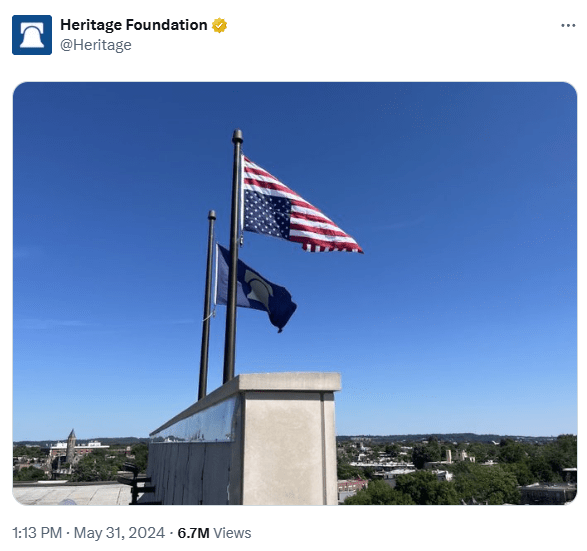from the burn-baby-burn dept
You may recall that Donald Trump and his supporters have insisted that he’s the “free speech” President. His first day in office this term, he issued an executive order “restoring free speech” saying that “no Federal Government officer, employee, or agent engages in or facilitates any conduct that would unconstitutionally abridge the free speech of any American citizen.”
Well, I’d like to report a federal government officer violating that executive order… in the form of the President of the United States issuing another executive order which tries (weakly) to figure out a way to criminalize the burning of the American flag, which is not something the President can actually do.
Our great American Flag is the most sacred and cherished symbol of the United States of America, and of American freedom, identity, and strength. Over nearly two-and-a-half centuries, many thousands of American patriots have fought, bled, and died to keep the Stars and Stripes waving proudly. The American Flag is a special symbol in our national life that should unite and represent all Americans of every background and walk of life. Desecrating it is uniquely offensive and provocative. It is a statement of contempt, hostility, and violence against our Nation — the clearest possible expression of opposition to the political union that preserves our rights, liberty, and security. Burning this representation of America may incite violence and riot. American Flag burning is also used by groups of foreign nationals as a calculated act to intimidate and threaten violence against Americans because of their nationality and place of birth.
The executive order is so weak because, as it acknowledges, the Supreme Court has made it clear that the burning of the American flag is almost always protected expression under the First Amendment.
Most notably, in Texas v. Johnson in 1989, the Supreme Court was pretty clear about all this. As the Court stated explicitly:
If there is a bedrock principle underlying the First Amendment, it is that the government may not prohibit the expression of an idea simply because society finds the idea itself offensive or disagreeable.
It also highlights the point that flag burning is not just highly expressive, but the fact that America allows for the burning of its flag as a form of speech highlights American ideals:
We are tempted to say, in fact, that the flag’s deservedly cherished place in our community will be strengthened, not weakened, by our holding today. Our decision is a reaffirmation of the principles of freedom and inclusiveness that the flag best reflects, and of the conviction that our toleration of criticism such as Johnson’s is a sign and source of our strength. Indeed, one of the proudest images of our flag, the one immortalized in our own national anthem, is of the bombardment it survived at Fort McHenry. It is the Nation’s resilience, not its rigidity, that Texas sees reflected in the flag — and it is that resilience that we reassert today.
The way to preserve the flag’s special role is not to punish those who feel differently about these matters. It is to persuade them that they are wrong.
And, of course, the MAGA crowd knows all of this even if they’re pretending to forget it this week. You may recall that just last year the Heritage Foundation chose to fly the American flag upside down over its headquarters after Donald Trump was found guilty by a jury.

Similarly, the very MAGA Supreme Court Justice, Samuel Alito, was found to have flown an American flag upside down (he blamed his even more MAGA wife).

So, yes, MAGA folks know that the “desecrating” the flag is a form of expression.
The executive order pretends to get around all of this by pretending that it’s only talking about “unconstitutional” versions of flag burning, which they claim are when it amounts to “fighting words” or likely to incite imminent lawless action:
Notwithstanding the Supreme Court’s rulings on First Amendment protections, the Court has never held that American Flag desecration conducted in a manner that is likely to incite imminent lawless action or that is an action amounting to “fighting words” is constitutionally protected.
This is constitutional nonsense on multiple levels. The “fighting words” exception has been effectively neutered by decades of Supreme Court decisions, and the Brandenburg “imminent lawless action” standard sets an incredibly high bar that peaceful flag burning never meets.
More fundamentally, the EO falsely claims these exceptions haven’t been tested in flag burning cases. That’s wrong. Texas v. Johnson directly addressed both, starting with “fighting words”:
Nor does Johnson’s expressive conduct fall within that small class of “fighting words” that are “likely to provoke the average person to retaliation, and thereby cause a breach of the peace.” Chaplinsky v. New Hampshire, 315 U. S. 568, 315 U. S. 574 (1942). No reasonable onlooker would have regarded Johnson’s generalized expression of dissatisfaction with the policies of the Federal Government as a direct personal insult or an invitation to exchange fisticuffs.
As for imminent lawless action, the court similarly rejected that argument from Texas in the same case, first saying that nothing in the ruling prevents Texas from keeping the peace:
We thus conclude that the State’s interest in maintaining order is not implicated on these facts. The State need not worry that our holding will disable it from preserving the peace. We do not suggest that the First Amendment forbids a State to prevent “imminent lawless action.” Brandenburg, supra, at 395 U. S. 447. And, in fact, Texas already has a statute specifically prohibiting breaches of the peace, Tex.Penal Code Ann. § 42.01 (1989), which tends to confirm that Texas need not punish this flag desecration in order to keep the peace.
But it notes that simply burning the flag does nothing at all that could be considered as such:
Texas claims that its interest in preventing breaches of the peace justifies Johnson’s conviction for flag desecration.
However, no disturbance of the peace actually occurred or threatened to occur because of Johnson’s burning of the flag. Although the State stresses the disruptive behavior of the protestors during their march toward City Hall, Brief for Petitioner 34-36, it admits that “no actual breach of the peace occurred at the time of the flagburning or in response to the flagburning.” Id. at 34. The State’s emphasis on the protestors’ disorderly actions prior to arriving at City Hall is not only somewhat surprising, given that no charges were brought on the basis of this conduct, but it also fails to show that a disturbance of the peace was a likely reaction to Johnson’s conduct. The only evidence offered by the State at trial to show the reaction to Johnson’s actions was the testimony of several persons who had been seriously offended by the flag burning. Id. at 6-7.
The State’s position, therefore, amounts to a claim that an audience that takes serious offense at particular expression is necessarily likely to disturb the peace, and that the expression may be prohibited on this basis. Our precedents do not countenance such a presumption. On the contrary, they recognize that a principal “function of free speech under our system of government is to invite dispute. It may indeed best serve its high purpose when it induces a condition of unrest, creates dissatisfaction with conditions as they are, or even stirs people to anger.”
In other words, the executive order is hot garbage.
It is an attack on the First Amendment while pretending otherwise. It seems little more than a provocation trying to overturn Texas v. Johnson by pretending there could be some form of flag burning protest which could be criminalized.
Trump’s remarks while signing the order reveal the real game. He attacks Texas v. Johnson as coming “from a very sad court” before launching into fabricated claims about flag-burning riots:
The transcript speaks for itself (in part by showing how much word salad this man spews):
This is very important. Flag burning all over the country. They’re burning flags all over the world. They burn the American flag.
And as you know, through a very sad court, I guess it was a five to four decision, they called it freedom of speech.
But there’s another reason which is perhaps much more important. It’s called death. Because what happens when you burn a flag is the area goes crazy.
If you have hundreds of people, they go crazy. You can do other things. You can burn this piece of paper. You can and it’s but when you burn the American flag, it incites riots at levels that we’ve never seen before.
People go crazy in a way both ways. There are some that are going crazy for doing it. There are others that are angry angry about them doing it.
A good reporter would ask for a single example of someone burning a flag (let alone it “happening all over the country”) where hundreds of people went crazy and started “riots at levels that we’ve never seen before.”
None of this happened.
But it’s clear the intent here is to try to overturn Texas v. Johnson and use it to imprison anyone who is protesting Trump’s fascistic tendencies. Even though the EO pretends that this will only lead to prosecution if the flag burning is done to incite violence, Trump then makes it clear he thinks the flag burning alone deserves a year in prison (something he doesn’t get to decide, he’s not a king).
And what the penalty is going to be if you burn a flag you get one year in jail. No early uh exits. No, nothing. You get one year in jail.
He then claims as soon as he signs it, flag burning will stop immediately.
Except, of course, the opposite happened. Later in the day after signing it, an American veteran went in front of the White House in a clear sign of expressive protest, announced he was burning a flag to protest Donald Trump and his signing of the executive order:
And no riot occurred. No violence. No death. But the guy was still arrested for exercising his free speech:
This arrest proves the executive order’s real purpose in real time. There was no “imminent lawless action.” No “fighting words.” No riots or violence—just peaceful symbolic speech criticizing the government. Yet the speaker was criminalized anyway, demonstrating that this isn’t about preventing violence or maintaining order. It’s about using state power to silence dissent and punish symbolic speech that criticizes the government.
This is what authoritarianism looks like in practice: using the power of the state to criminalize symbolic criticism of the government while wrapping it in patriotic rhetoric. Trump’s executive order isn’t about protecting the flag—it’s about weaponizing law enforcement against dissent. And the fact that he’s doing this while simultaneously claiming to be the champion of “free speech” only makes the constitutional violation more brazen.
The Supreme Court got it right in Texas v. Johnson: “The way to preserve the flag’s special role is not to punish those who feel differently about these matters. It is to persuade them that they are wrong.” Trump’s approach does the opposite—it reveals a government so insecure that it must silence its critics rather than answer them.
Filed Under: 1st amendment, donald trump, executive orders, fascist, fighting words, flag burning, free speech, incitement, protest










